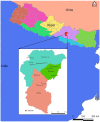Antibiotic Use in Broiler Poultry Farms in Kathmandu Valley of Nepal: Which Antibiotics and Why?
- PMID: 33916475
- PMCID: PMC8167706
- DOI: 10.3390/tropicalmed6020047
Antibiotic Use in Broiler Poultry Farms in Kathmandu Valley of Nepal: Which Antibiotics and Why?
Abstract
Inappropriate antibiotic use in food-producing animals is associated with the emergence and spread of antibiotic resistance. In industrial broiler poultry farms in three districts of Kathmandu valley, Nepal, we assessed antibiotic use prevalence, and their classes, types, and quantities. A cross-sectional questionnaire study involving field visits to large poultry farms (flock size ≥ 3000) of the Kathmandu, Bhaktapur, and Lalitpur districts was conducted. Of 30 farms (total flock size 104,200; range 3000-6000), prevalence of antibiotic use was 90% (95% CI: 73-98%). Six (22%) farms used antibiotics as prophylaxis, while 21 (78%) used it for therapeutics. Seven antibiotics from six classes (including quinolones, macrolides, and polymyxins) were used. The most commonly used antibiotics were tylosin (47%), colistin (47%), and dual therapies with neomycin and doxycycline (33%). A total of 50,000 grams of antibiotics (total weight including active and inactive ingredients) were used (0.5 grams/chicken/45 days of flock life) with eight (26%) farms using more than two antibiotics. No farms had records on clinical indications for prophylaxis or treatment. No post-mortem records of sick birds were available. Prevalence of antibiotic use in broiler farms of Kathmandu valley is high and includes "highest priority critically important antibiotics" for human use, with direct implications on public health.
Keywords: One Health; SORT IT; antibiotic use; antibiotics stewardship; antimicrobial resistance; food producing animals.
Conflict of interest statement
The authors declare no conflict of interest.
Figures
Similar articles
-
Antimicrobial stewardship hindered by inadequate biosecurity and biosafety practices, and inappropriate antibiotics usage in poultry farms of Nepal-A pilot study.PLoS One. 2024 Mar 1;19(3):e0296911. doi: 10.1371/journal.pone.0296911. eCollection 2024. PLoS One. 2024. PMID: 38427679 Free PMC article.
-
Risk factors associated with Avian Influenza subtype H9 outbreaks in poultry farms in Kathmandu valley, Nepal.PLoS One. 2020 Apr 2;15(4):e0223550. doi: 10.1371/journal.pone.0223550. eCollection 2020. PLoS One. 2020. PMID: 32240166 Free PMC article.
-
The Prevalence and Risk Factors Associated with the Presence of Antibiotic Residues in Milk from Peri-Urban Dairy Cattle Farms in Kathmandu, Nepal.Antibiotics (Basel). 2025 Jan 16;14(1):98. doi: 10.3390/antibiotics14010098. Antibiotics (Basel). 2025. PMID: 39858383 Free PMC article.
-
The application of antibiotics in broiler production and the resulting antibiotic resistance in Escherichia coli: A global overview.Poult Sci. 2019 Apr 1;98(4):1791-1804. doi: 10.3382/ps/pey539. Poult Sci. 2019. PMID: 30544256 Free PMC article. Review.
-
Farm to table: colistin resistance hitchhiking through food.Arch Microbiol. 2023 Apr 4;205(5):167. doi: 10.1007/s00203-023-03476-1. Arch Microbiol. 2023. PMID: 37014461 Review.
Cited by
-
Potential Feed Additives as Antibiotic Alternatives in Broiler Production.Front Vet Sci. 2022 Jun 17;9:916473. doi: 10.3389/fvets.2022.916473. eCollection 2022. Front Vet Sci. 2022. PMID: 35782570 Free PMC article. Review.
-
Antibiotic usage practices and its drivers in commercial chicken production in Bangladesh.PLoS One. 2022 Oct 17;17(10):e0276158. doi: 10.1371/journal.pone.0276158. eCollection 2022. PLoS One. 2022. PMID: 36251714 Free PMC article.
-
Determinants of indiscriminate antimicrobial use in commercial chicken farms in Bangladesh and their impact on food safety and public health.Sci Rep. 2025 Aug 17;15(1):30103. doi: 10.1038/s41598-025-14108-7. Sci Rep. 2025. PMID: 40820200 Free PMC article.
-
Antimicrobial stewardship hindered by inadequate biosecurity and biosafety practices, and inappropriate antibiotics usage in poultry farms of Nepal-A pilot study.PLoS One. 2024 Mar 1;19(3):e0296911. doi: 10.1371/journal.pone.0296911. eCollection 2024. PLoS One. 2024. PMID: 38427679 Free PMC article.
-
Antimicrobial resistance, virulence associated genes and phylogenetic background versus plasmid replicon types: the possible associations in avian pathogenic Escherichia coli (APEC).BMC Vet Res. 2022 Nov 30;18(1):421. doi: 10.1186/s12917-022-03496-x. BMC Vet Res. 2022. PMID: 36447231 Free PMC article.
References
-
- World Health Organization Global Action Plan on Antimicrobial Resistance. [(accessed on 24 August 2020)];2015 Available online: https://www.who.int/antimicrobial-resistance/global-action-plan/en/
-
- Tang K.L., Caffrey N.P., Nóbrega D.B., Cork S.C., Ronksley P.E., Barkema H.W., Polachek A.J., Ganshorn H., Sharma N., Kellner J.D., et al. Restricting the use of antibiotics in food-producing animals and its associations with antibiotic resistance in food-producing animals and human beings: A systematic review and meta-analysis. Lancet Planet. Health. 2017;1:e316–e327. doi: 10.1016/S2542-5196(17)30141-9. - DOI - PMC - PubMed
-
- Zellweger R.M., Carrique-Mas J., Limmathurotsakul D., Day N.P.J., Thwaites G.E., Baker S., Ashley E., De Balogh K., Baird K., Basnyat B., et al. A current perspective on antimicrobial resistance in Southeast Asia. J. Antimicrob. Chemother. 2017;72:2963–2972. doi: 10.1093/jac/dkx260. - DOI - PMC - PubMed
-
- Darwish W.S., Eldaly A.E., El-Abbasy M.T., Ikenaka Y., Nakayama S., Ishizuka M. Antibiotic residues in food: The African scenario. Jpn. J. Vet. Res. 2013;61:S13–S22. - PubMed
-
- World Health Organization WHO Guidelines on Use of Medically Important Antimicrobials in Food Producing Animals. [(accessed on 25 January 2021)];2017 Available online: https://apps.who.int/iris/bitstream/handle/10665/259243/WHO-NMH-FOS-FZD-.... - PubMed
Grants and funding
LinkOut - more resources
Full Text Sources
Other Literature Sources


